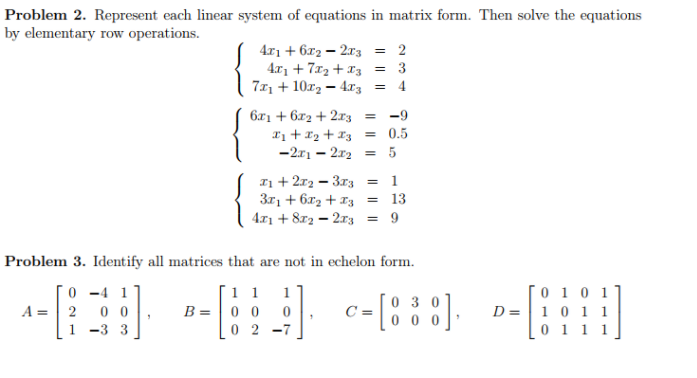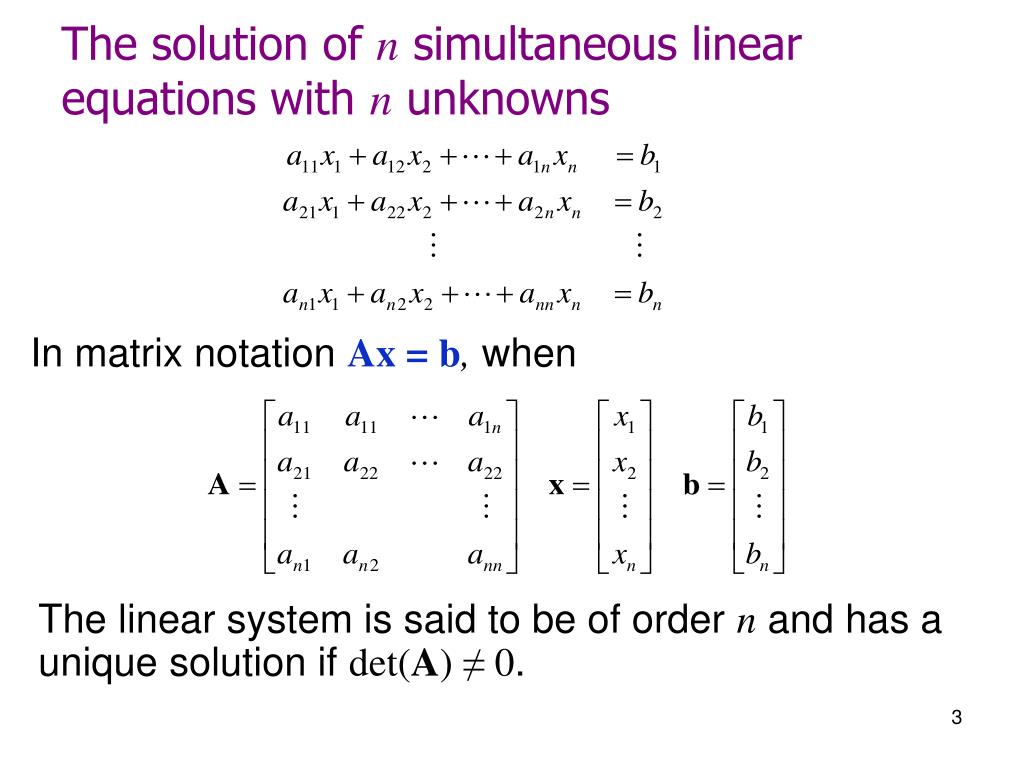
This venture will be illustrated with empirical case studies, many from our own research.In numerical linear algebra, the tridiagonal matrix algorithm, also known as the Thomas algorithm (named after Llewellyn Thomas), is a simplified form of Gaussian elimination that can be used to solve tridiagonal systems of equations. The purpose of the paper is therefore to find out whether the notions of culture and lifestyle can become an integral part of our conceptual framework, and what the added value of integrating these notions is for understanding the meaning of a dwelling. Although these notions have been touched upon in our research, their possible role as analytical concepts has not clearly been indicated. Our conceptual framework seems to have several interfaces with the more familiar notions of culture and lifestyle, which are quite frequently used in studies on the meaning of a dwelling.
SOLUTION OF LINEAR EQUATION SYSTEMS WITH MATRIX OPERATIONS HOW TO
I am having trouble figuring out how to do so, I have tried the backslash operator.

I need to solve for the coefficients of x, given that x is a 3x3 matrix. I have a system of linear equations for a problem that can be generically expressed as Ax b. The focus of our own research is on the middle-level and lower-level meanings of fixed features. Solving System of Linear Equations with matrix operations. world views), middle-level meanings (e.g. The second one concerns the concept of meaning, distinguishing between high-level meanings (e.g. fixed features (physical aspects), semi-fixed features (furnishings) and non-fixed features (activities and behaviour). The first theoretical distinction concerns the concept of dwelling, defined as a system of settings in which a certain system of activities takes place and makes a distinction between. In our research we use a conceptual framework that is based on two theoretical distinctions. The meaning of a dwelling, sometimes called the meaning of "home," has been studied from many different perspectives. On the basis of the detailed response analysis, modified genetic decompositions are proposed for the matrix order concept, matrix transpose concept and for matrix operations. It was observed that the schemata for basic algebra and real number are necessary for the conceptual development of matrix algebra, and that familiarity of the correct use of terminology and notations promotes the earning of matrix algebra.

In terms of APOS theory, the responses revealed that most pre-service teachers were operating at action and process stages, with few operating at the object stage. The findings revealed that the mental constructions made by pre-service teachers in most cases concur with the preliminary genetic decomposition. The study is underpinned by APOS theory (action-process-object-schema). The aim was to explore their mental constructions of matrix algebra concepts and how they concur with a preliminary genetic decomposition. In this preliminary study the data was collected from 85 pre-service teachers through a structured activity sheet. The study was guided by the belief that understanding the mental constructions the pre-service teachers make when learning matrix algebra concepts leads to improved instructional methods. This study is part of ongoing research in undergraduate mathematics education. Further research is needed to explore instructional approaches instructors could adopt to help students develop a robust understanding of multivariable optimization problems and the methods used to solve these problems. This study has characterized students' difficulties when solving multivariable optimization problems. Fourth, solving systems of nonlinear equations to find critical points of the objective function in each task was particularly challenging for nearly half of the students. showing that the dimensions students found in each task are dimensions of largest volume object) was problematic for a majority of the students. Third, verifying/justifying extrema (i.e. eliminating one of the variables from the objective function, finding partial derivatives, and solving the simultaneous equations that result) to find the critical points of the objective function in each task. Second, most of the students successfully used the Lagrange Multiplier method or the Substitution method (i.e.

the function whose maximum or minimum value(s) is to be found) in each task came easily for 15 students who participated in the study. First, formulating the objective function (i.e.

There are four major findings from this study. This study used task-based interviews to examine students' reasoning about multivariable optimization problems in a volume maxi-mization context.


 0 kommentar(er)
0 kommentar(er)
